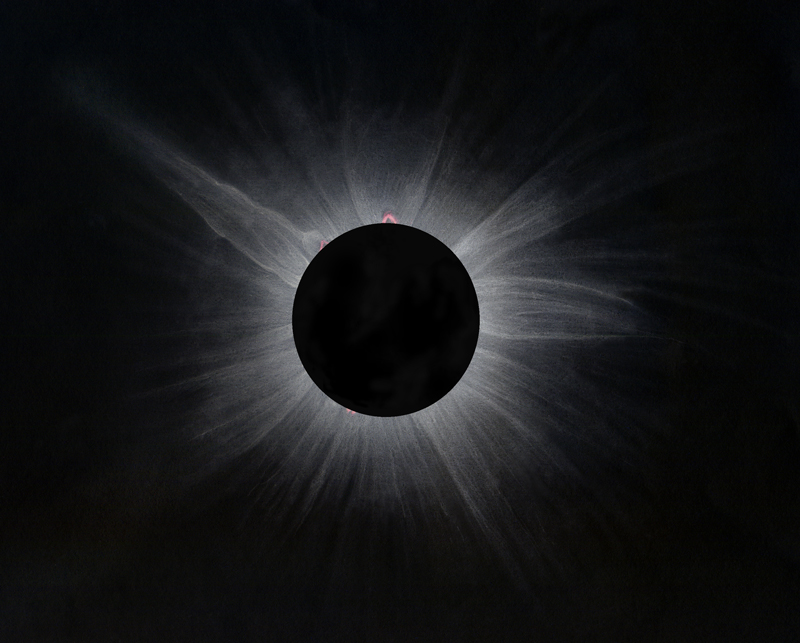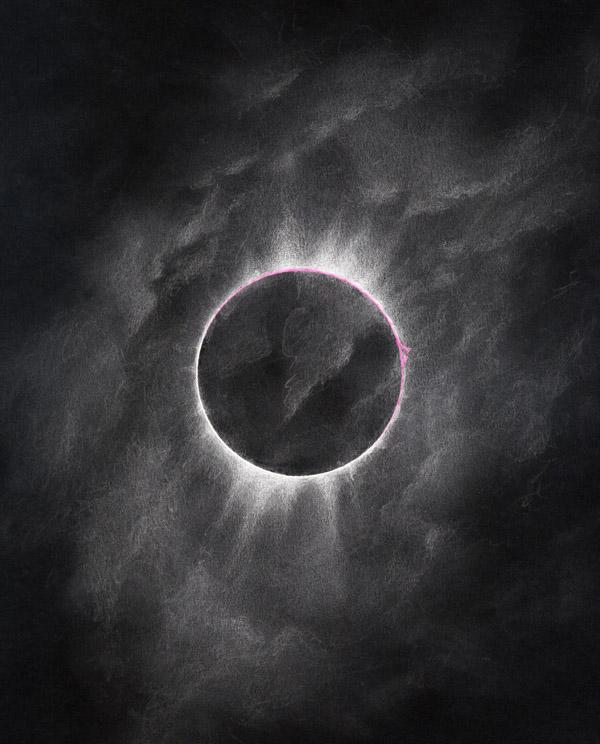
A sketch of the total éclipse in Australia, 1km north of Palm River.
Perfect observing, with L80x40 majority time and 15 seconds fabulous in T400-c x 80, realy fantastic!
Desoled for my English
Serge
Hey artists!
This is my first and only total eclipse of the sun. It is only > one thing to say, beautiful, and this is still
my finest minutes as an amateurastronomer!
The eclipse started with a long lasting diamondring, and ended > with a shorter one.
Info on my sketch!
Best wishes and clear sky from Per-Jonny Bremseth

Eclipse at Totality July 22, 2009
Sketch and Details by Serge Vieillard
Back in China for the eclipse of the century, that of July 22, 2009 and again a great trip… At the end of monsoon, the place of observation is very difficult to choose. The weather statistics make us prefer the area near Shanghai. Very wisely, we provided a bus to have a certain latitude of mobility to adjust our position at the last moment. The day before the eclipse, a violent storm broke out as the announced schedule. It is imperative to move towards the southwest and 300 km. away. A cloud deprives us of the sunrise but ascending into heaven, the sun finally appears in an area spared…. The lights dim and the lighting of the sodium lighting of the highway rest area where we were was depriving us of the special ambiance of this characteristic pale light before totality. Planets and stars are invisible. In contrast, the 2nd and 3rd contacts are beautiful, gently attenuated by the clouds. I have seen without the filter L80x20 the last ray of light and fabulous appearance of the pink chromosphere. Only very low crown pierces and irradiates the nearby clouds, showing a certain luminous flows. It is almost impossible to guess the general form and extensions of various plumes, drowning, tangled and modifying themselves to suit the rapidly changing clouds. At the maximum, the urge to stop everything takes me to this sketch… But then there is a magnificent chromosphere, a protuberance which only extends to the approach of the 3rd contact giving me the urge to continue this work and transcribe this unusual vision. Diamonds are beautiful, followed by a string of fine grains of Bailly, easy to follow without a filter for several seconds. Although at the time, I felt some disappointment at this show ruined by clouds, I savored the benefit-post, glad to have been among the privileged few to have seen in its entirety.
Translation by Frank McCabe
Total Solar Eclipse – August 2, 2008
Sketch by Serge Vieillard
Serge Vieillard made this sketch of the total solar eclipse of 2008 from the Gobi Desert in China. In the minutes leading up to totality, clouds threatened to hide the event from his eyes. He raced 1000 meters from his initial location to find a clear spot, only to have the clouds drift there as well. In the final moments however, the clouds broke and he was able to spend an ecstatic 2 minutes drawing the view through his Kowa TSN-2 77 mm spotting scope at 20X. As the seconds passed and his eyes adapted, he crafted the increasingly complex, asymmetrical contours of the Solar corona and noted a bright star in Cancer. During the final few seconds of totality, the pink bloom of a prominence emerged and topped off an exciting and memorable observation.
Solar Eclipse
Sketch and Details by Ernest Shekolyan
That was so great event! I do not know what was more exiting in this solar eclipse – just one hour clear sky over Novosibirsk or magic view of black sun in shining coronary ring. Whole day before this short eclipse were partial or continuous clouds, but no one after the first contact! In comparison to eclipse 29 april 2006 corona was not so bright and contrast.
Draft of the sketch (pencil on white paper) was made in few minutes after end of the total phase. Then in 12 hours it was made final version of the sketch (the same pencil, but with better quality).
Ernest
Solar Eclipse
By Serge Vieillard
If you were about to experience the brief but awesome spectacle of a solar eclipse, would you take the time to immerse yourself in a sketch of the event? If you have a passion for sketching astronomical objects and events, you may find yourself attempting what Serge Vieillard did. On March 29, 2006, Serge and 14 other club members journeyed to the Sahara Desert in Libya to view the eclipse. Racing across the dusty landscape in 4x4s to arrive at the site on time, they set up to the southeast of the volcano, Waw Enamous. As the eclipsed deepened, they found themselves entranced by an indescribable atmosphere: the sky darkened, Venus appeared, shadows began to shift, Bailley’s Beads began to sparkle, leading finally to totality. With that, the immense corona blossomed before them while solar prominences emerged and evolved as the moon passed before them.
Rather than photograph this awe inspiring event, Serge chose to harken back to an earlier era of astronomy and he sketched it instead. Because totality would only last 4 minutes, he had to be fast and deliberate in his sketching method, observing with a Kowa 77 mm TSN-2 for wide views of the corona, and a Meade ETX-90 at 100X for viewing the prominences. During those brief 4 minutes, Serge sketched the main contours of the corona, and sketched in the positions of the dancing prominences. Immediately after totality broke, he spent the next several minutes finishing the details of the sketch while it was still fresh in his mind.
Serge used colored pencils to add color to the sketch. However, since he was drawing on white paper and would be inverting it after scanning, he used a technique adapted from his previous color observations and sketches of M42, the Great Orion Nebula. By pre-testing, scanning, and inverting the color values of several pencils, he was able to determine what colors would produce the best color once the sketch was inverted after scanning. The results speak for themselves in this outstanding illustration.
The entry from Serge’s website is included below in the original French. (Google Language Tools may be helpful in translating if you do not read French.) More of Serge’s incredible sketches can be found at his website: ASTRONOMIE AMATEUR OBSERVATION VISUELLE CROQUIS ASTRO.
Eclipse totale du 26 mars 2006, dans le désert Libyen, au sud est du volcan waw Enamous. Une aventure exceptionnelle que nous avons vécue avec 14 copains(es) du club. Découverte d’un pays, du Sahara, d’un autre mode de vie. Course effrénée des 4×4 dans la poussière pour être présent sur le site au bon moment. Une ambiance indescriptible, assombrissement du ciel, apparition de Vénus, des ombres volantes partout, les premiers grains de Bailly, arrachage des filtres et ça y est ! Couronne solaire énorme, nombreuses protubérances dont la visibilité évoluera au fil du phénomène selon de déplacement de la lune. J’ai tenté ce croquis, évoquant à l’ère du numérique une astronomie d’une autre époque, ambiance 1900, à l’oculaire de la longue vue L80 pour la couronne et de l’ETX x100 pour les protubérances. Les 4 minutes sont passées comme un éclair. Je n’ai eu le temps que de marquer au mieux le contour des différents panaches. Tout de suite après la totalité, l’image encore en mémoire, j’ai apporté la texture particulière et les finitions pour ce résultat étrange…
Total Solar Eclipse 19th Century
This is a painting in David P. Todd’s, A New Astronomy © 1897, American Book
Company by the 19th century German painter W. Kranz. Unfortunately this beautiful
plate is water damaged top center in my copy of the textbook. The author retrieved
this plate from “Himmel und erde” edited by Dr. Schwahn. Another painting by Kranz
can be found at the LPOD website May 29, 2006. The image on LPOD is a poorly
scanned copy. I have seen a number of Kranz’s drawings and paintings and I tend to
think of him as a19th century forerunner to the great 20th century artist, Chesley
Bonestell.
David P. Todd writes this on pages 297-298 about W. Kranz’s painting in the
frontispiece:
“…Total eclipses occurring near the middle of the year are longest, if at the same
time the moon is near perigee, and their paths fall within the tropics. Always
after total eclipse is over, the partial phase begins again, growing smaller and
smaller and the sun getting continually brighter, until last contact when full
sunlight has returned.… If the atmosphere is saturated with aqueous vapor, weird
color effects ensue, by no means overdrawn in the frontispiece.”
Frank McCabe
Eclipse
The total solar eclipse seen from the Turkish Mediterranean coast last year
was our first eclipse. It was an overwhelming and unforgettable experience.
We wanted to soak up the spectacle and so deliberately did not take a
camera, our only equipment was binoculars for a quick look at prominences
and the corona immediately after the start of totality.
All the textbook sights were there, Venus and Mercury before totality, the
pink prominences, a gauzy corona pearly white and twisted and pulled by the
sun’s magnetic fields, diamond rings whiter than diamonds and the receding
lunar shadow blotting out distant mountains. That much was expected. But the
overpowering impressions were the ones that were not expected. The point
like sun and greying light before totality like being in a steel tank lit by
a single light bulb. The rapid and wholly shocking plunge downwards in light
as totality started. The swiftly changing and blazing diamond rings, the
sheer speed of it all. For the first time we got the real sense that we were
on a turning Earth with the Moon and Sun shifting and moving in the heavens.
This little acrylic on board painting tries to sum up those impressions. It
fails miserably – but then what could succeed when pitted against a real
solar eclipse!
Les Cowley